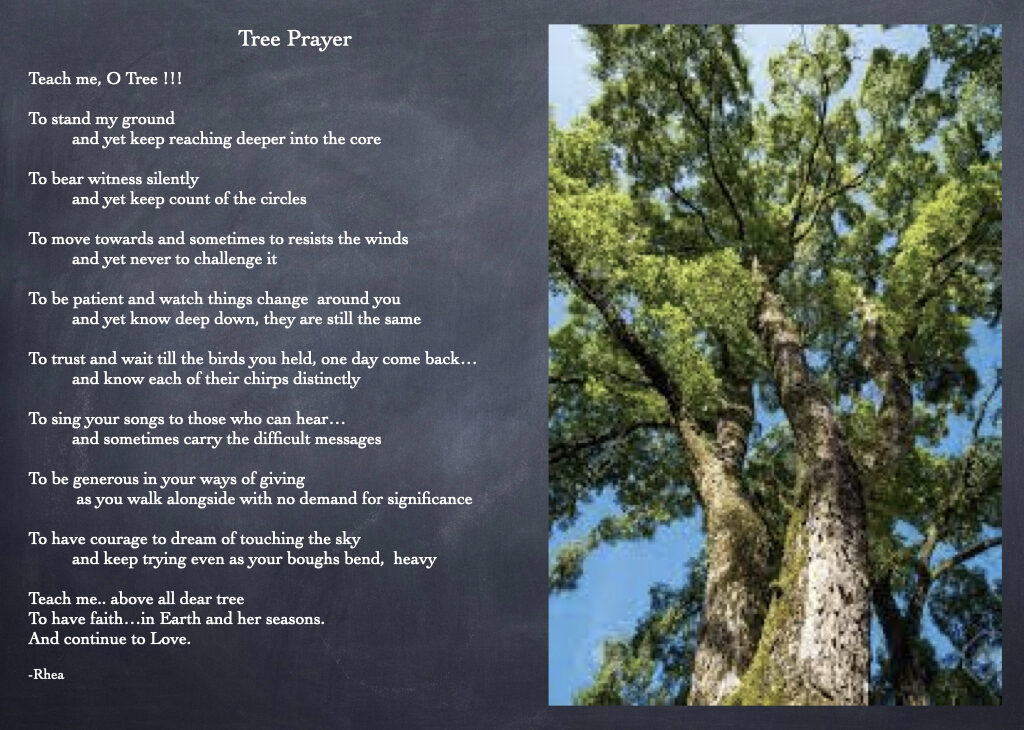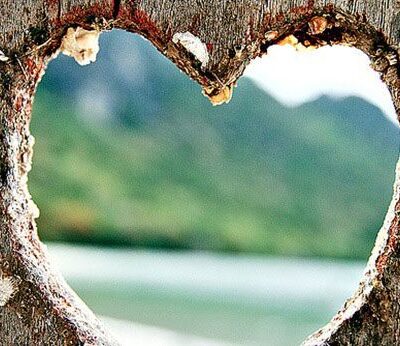Yesterday we got all excited about a commissioned painting, that my husband is going to make. While discussing how I wanted my portrait. I realized I wanted a portrait with a Tree.
That I have been fond of trees is an understatement. I do feel I was raised by trees. Literally. Growing up in my grandmas house. I spend more time under and on trees than inside the house. Some nights I also went to sleep under them. We had a custard apple tree. These are structured like huge trees but are shorter and the fruit can be assessed by a child. I remember asking my grandma if I could pluck the custard apple.
And she would say,
Do you see the custard apple growing on me – ehh.. No
Where is it then – On the tree
So who should you ask permission? – The tree ofcourse. Duh!!
So that was that – that is how I learnt to speak to trees, I would ask them permission for fruits or flowers and sometimes they said yes and sometimes they said no and nobody frowned or were surprised when they saw me talking to trees. It was a normal everyday thing.
Many afternoons, lying under the guava tree. I would watch the parrots come since they loved guava. They would just eat the seeds not the pulpy fruit. For years, that is how I ate guava also. Just the seeds.
Ofcourse, when I started school and one day some of my friends just plucked some flowers or leaves for some school project – I was horrified. I asked them, simply, if they had taken permission from the plant. You can imagine what happened. I still remember, my friends all looked at me strangely and then at each other and started to laugh. Mad or what?
She is crazy – stuck
I remember feeling very confused, hurt, angry and sad.
For myself and the trees and plants that were not listened to. Eventually I think I became angry about voices that were not listened to. And became their voice.
I have gone and still do, to trees and stood and hugged and held them and felt held and hugged in return. Told them of things I could not share with anyone. I feel they know me. Like nobody else does.
Trees are fascinating. They are such an epitome of patience, strength endurance and wisdom. I always wonder how they go against all the gravitational pull and still reach for the sky. While at the same time growing deeper and deeper roots to the heart of the earth. They grow in circles, but never the same ones. And keep track of them. If we see a cross section we can count a trees age.
The idea that humans are intimately connected to the earth has persisted throughout human history and across cultures. This connection was most recently described by eminent biogeographer E.O. Wilson in his 1984 book Biophilia. Wilson notes that humans naturally like to be around other living things.
Trees are bridges. They connect ancient past and future. They just stand there and bear witness to everything that is going on, quietly. They connect the earth and heaven.
A revolution has been taking place in the scientific understanding of trees also.
Peter Wohlleben, a German forester and author of “The hidden life of trees” is the first writer to convey its amazements to a general audience. The latest scientific studies, confirm what he has long suspected from close observation in forests. Trees are far more alert, social, sophisticated—and even intelligent—than we thought.
Trees of the same species are communal, and will often form alliances with trees of other species. Forest trees have evolved to live in cooperative, interdependent relationships, maintained by communication and a collective intelligence similar to an insect colony. These soaring columns of living wood draw the eyes upwards
They are connected to each other through underground fungal networks. Trees share water and nutrients through the networks, and also use them to communicate. They send distress signals about drought and disease, for example, or insect attacks, and other trees alter their behavior when they receive these messages. Some people are calling it the ‘wood-wide web,’

The Tree hugging Movement “Chipko” was started in a small Indian Village: A young girl was reportedly the first to see the loggers coming. It was March 26, 1973, and loggers sent by sporting goods manufacturer the Simon Company were heading for Gopeshwar forest near the tiny village of Reni in Uttarakhand, which was then part of Uttar Pradesh. The girl ran to tell Gaura Devi, a village elder, who summoned dozens of other women to do the only thing they could: place their bodies between the trees and the axes. They hugged the 300 ash trees tightly, telling the loggers that in order to get to the trees they’d have to go through human bodies first. The loggers opted to leave instead. But Devi and the other women remained vigilant.
Perhaps this way of being is something that we as human must aspire for – me thinks.
This story brings back a memory from some years ago, while working with a group of tribals from Jharkhand. One of them, Badua, one day came to me and stood looking directly at me. I felt uncomfortable but not in a bad way. After a long pause, in which I did not know what do, he said. You are a Sal tree. Just like that he made the assessment and announcement. He said something about how a Sal tree is one of the few trees which has “feminine and masculine” energy. My friend Savvy and I would say Saltree and laugh at our own silly joke for like a hundred times. I did not really look up Sal tree or what that comment meant until today.
What I am discovering is astounding. I feel at once in awe and humbled and a kind of coming home

Sal tree is also known as Shorea robusta, shala tree, sakhua, or sarai, is a species of tree in the family Dipterocarpacea. My pet name growing up was Shalu – coincidence?
Sal is believed to be the “House of Tribal Goddess” and is valued as a holy tree. It has religious, medicinal as well as commercial significance and its wood is used in the furniture industry. In Hindu tradition, the sal tree is said to be favoured by Vishnu. Its name shala, or sal, comes from Sanskrit literally “house” wow!!
There is a standard decorative element of Hindu Indian sculpture which originated in a yakshi grasping the branch of a flowering tree while setting her foot against its roots. This decorative sculptural element was integrated into Indian temple architecture as salabhanjika or “sal tree maiden”. In Buddhism, the brief flowering of the Sal tree is used as a symbol of Impermanence.
Sigh !!!!!
Just reading all this is giving me goose bumps. I have always liked the Sal tree but never knew why. I loved it because the flower looks like Vishnu’s snake hood covering the small shiv ling. It also has a strong fragrance. I do identify most with a tree.
Perhaps we are trees. We are the oxygen we breathe from them. And one day we will be them again . Perhaps we need to emulate them. Perhaps we love them so much, because they at once raise our eyes towards the heaven and feet to the ground.
Some months ago, in the storm when so many trees were uprooted and died. I felt such deep pain and grief in the pit of my stomach. I bawled and cried. My husband and I then went and did a grief ritual for the trees. I thought it was only fair, they are with us in our last journey, as pyre wood or caskets, why should we not be with them on theirs?
Infact if we think deeply, trees are with us throughout our lives in different forms. Right from the cradle, to the bat, to the pencil and note books, to the house we build, match stick and fire wood, to eventually the cane and then the casket.
Perhaps we need to spend more time with the trees. Maybe they can and have a way to help humanity know how to live and die. Perhaps these tribals know the secret of living with, in and as nature. The Price we have paid for our urban comforts is own wellbeing. Maybe it’s time we prayed to trees. The living gods.







2 Comments